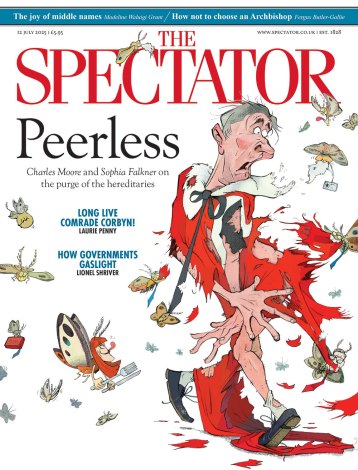Weird, stinky and occasionally deadly: not everyone can make heart room for mushrooms. But Richard Fortey, a palaeontologist who recently retired from his post at the Natural History Museum after more than three decades’ service, has always found ‘pleasure and perplexity’ in the ‘alien’ world of fungi.
In his lovably nerdish 2021 memoir A Curious Boy, Fortey credited the Observer’s Guide to Common Fungi with setting him on the path to a passionate life scientific. As the uncoordinated son of a sporty father (a champion fly fisherman who owned several fishing shops), the young naturalist got his teenage kicks stalking riverbanks and studying the strange organisms he found there. In 2006, he was even briefly credited with identifying a mushroom previously unknown to science. It later transpired that it was a known species that had migrated to the UK from Japan alongside its invasive host, Japanese knotweed.
Psychedelic fungi are found growing in a school playing field, giving a whole new meaning to the term ‘school trip’
Close Encounters of the Fungal Kind is an informative, anecdote-jammed treat for amateur mycologists like me. I love mushrooms, but have felt the lack of a well-written book on a subject, which seems to have fallen between the two cultures: scientists stick, bone dry, to the differences between the 14,000-plus species, while artier authors prefer to eulogise only a few. As both a beautiful, witty writer with a magpie eye for a good yarn and a rigorous scientist, Fortey fills that gap with this delectably accessible but comprehensive book.
Like Fortey, I’m clumsy and geeky. But on the fungal forays I began taking in my early twenties, I shared the hunter’s rush he describes, prowling through the woods at dawn with a mushroom knife, brush and basket. Although a predator of stationary prey, you still switch up your senses to take the right trail, the leaves beneath your feet, listening for the flies at your ankles and tuning into the scents rising from the soil that range from honey to Camembert.
As a lover of language, I’ve always relished the taxonomy as much as the flavours I’d later sizzle in butter and black pepper, spending train journeys home matching various mushroom names to literary genres and designing imaginary book covers. There’s crime (Destroying Angel); spy fiction (Amethyst Deceiver); fantasy (Scarlet Elf Cup); poetry (Dewdrop Bonnet); science fiction (Earthstar); adventure (Horn of Plenty); romance (Ballerina); literary fiction (Lemon Disco); vintage erotica (Phallus Impudicus); and perhaps more current niche erotica (Hairy Curtain Crust).
Although a stickler for the Latin names in his youth, Fortey has come round to the charms of the vernacular, and his book is loaded with delicious linguistic morsels – along with all the facts on morels. (He gloats that he found his best ever haul of edible Black Morels growing on bark chippings shovelled around the trees in his local supermarket car park.) And he explores all the topics that readers might find in my imagined literary genres: how mushrooms bring life and death to the trees and (in the most gruesome cases) animals around them; how some species must select and ‘marry’ others; how they travel, transform and spread their messages through tree roots in a ‘wood wide web’ (a concept which he acknowledges is alluring but may be more brutally competitive than the initial dream of interspecies co-operation first suggested).
The book guides amateurs through the differences between the gilled and spongy mushrooms, the brackets, truffles and microscopic mulchers – including a chapter named after his own children’s despairing category of ‘things on sticks’. Fortey revels in the ‘busy darkness’ beneath fallen logs and the bickering of mycologists long dead. Blenheim Park, we learn, is well known as the host of the Devil’s Bolete. In the mid-20th century two leading experts, A.A. Pearson and John Ramsbottom, engaged in fierce dispute about the toxicity of this toadstool, with the latter opting to eat a chunk of it. This was a decision he soon regretted, having to be guided back to his bus stop after being ‘quickly and abundantly sick’. He omitted to mention this in his 1949 book Mushrooms and Toadstools, which listed the organism as having recovered from it’s ‘evil reputation’, to be commonly eaten in Czechoslovakia.
I was disappointed not to find a chapter on the two Amazonian strains of plastic-eating fungus that may help save the planet from choking on carrier bags. But Fortey is enthusiastic about how mushrooms can help us, by flagging changes to the ecosystem and as medicines. As a man who has suffered from depression – for which he was prescribed pills which deadened a lively mind – he also expresses a cautious optimism that ‘magic mushrooms’ may prove a simpler, quicker and less addictive route to stable mental health for many who are struggling. His inner imp cannot suppress a joke about finding psychedelic fungi in a school playing field, giving a whole new meaning to the term ‘school trip’.
Because my children won’t eat ‘slimy’ mushrooms, it’s been years since I holstered my knife and hung up my basket. But Fortey’s book has inspired me to get out into the woods again. I’ll tread lightly and pluck sparingly. He reminds readers of the awful depletion caused by professional foragers, and the legal loopholes they can exploit to avoid being prosecuted by laws which protect only ‘plants’. These looters should remember that many of our native trees, mammals and insects will die without the mysterious seams of the mycological support system running beneath our feet – a fascinating reminder that nature’s first gold may be mould.







Comments